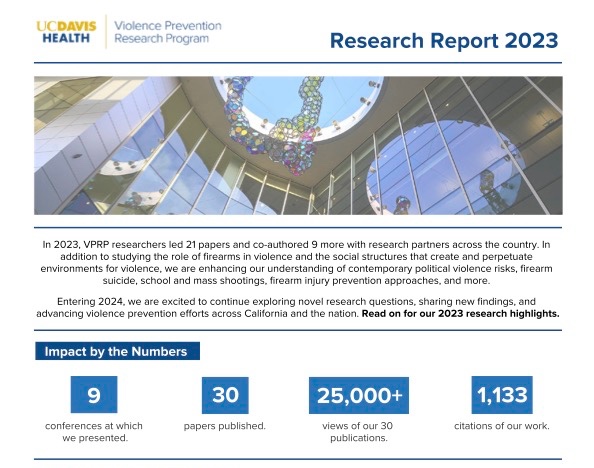Research Overview
Violence is preventable. VPRP’s mission is to develop and disseminate the research evidence on which informed violence prevention policy and practice are based. To do so, our robust research program examines violence –in all its forms– through the lenses of causes, consequences, and prevention:
- Causes of violence are behaviors or conditions that increase risk for violence.
- Consequences of violence may be immediately known or manifest in later years.
- Prevention of violence is the modification of violent behavior and promotion of safer communities through programs and policies.
For decades, VPRP conducted leading research on firearm violence and policy – often when few else did. As the field and funding for it has grown, so have we. To advance our research on violence and its prevention, we built a team with wide-ranging expertise, including medicine, epidemiology, statistics and biostatistics, sociology, criminology, law, economics, and policy analysis.
These fields converge with the public health approach to violence, a methodology and mindset VPRP director Dr. Garen Wintemute helped to develop in the 1980s. We still apply this approach to everything we do, looking at violence and its prevention as a population health issue. This means that in addition to studying the role of firearms, our team also researches the social structures that perpetuate and create environments for violence.
This is especially important because the burden of violence is not equally distributed across the population. Disparities driven by social and structural determinants of health – like racism and neighborhood disadvantage – are long-standing and increasing, further exacerbated by the COVID-19 pandemic. But our research demonstrates that strategic investment in historically marginalized communities, evidence-based policy, and community-driven violence prevention initiatives can lead to a safer, healthier, and more equitable future.
It may seem daunting, but incremental change adds up: we’ve done it in California. By layering policies that work in synergy to reduce risk, California’s gun violence rates steadily receded over at least the last two decades – a sharp contrast to the rest of the nation, which saw gun violence increasing over the same years. While the pandemic coincided with spikes in violence nationwide, including in California, the state today has one of the lowest firearm mortality rates in the country.
In looking at the next opportunities to prevent violence, there are many ways where VPRP is developing knowledge and driving change. We are defining the scope of firearm violence and proximity of risk in people’s daily lives. We are identifying firearm purchasing patterns of mass shooters and people at risk of suicide, which may be used to develop predictive tools to identify and prevent tragedies from occurring, and studying the policy tools already being used today. We’re teaching clinicians how to engage gun-owning patients respectfully and collaboratively to reduce their risk of harm. Through our newest area of scholarship, we are developing a greater understanding of contemporary political violence risks.
VPRP believes in the value of scientific research in addressing major health and social problems. Our team conducts research that informs policy and programs that prevent violence, enhance safety, and heal communities. Our work empowers communities to speak up to help realize a safer future. Together, we can change the trajectory of one of America's most significant public health problems.
This overview is adapted from a June 2023 “Spotlight on VPRP” commemorating National Gun Violence Awareness Day.
Publications
In 2023, VPRP researchers led 21 papers and co-authored 9 more with research partners across the country. In addition to studying the role of firearms in violence and the social structures that create and perpetuate environments for violence, we are enhancing our understanding of contemporary political violence risks, firearm suicide, school and mass shootings, firearm injury prevention approaches, and more. Check out our 2023 research report.

A complete listing of VPRP research publications can be accessed via our Google Scholar Library.
Having difficulty finding a publication? Email us and include "Information Request" in the subject line. We try to respond by the end of the next business day, but if your need is more urgent, be sure to let us know.
